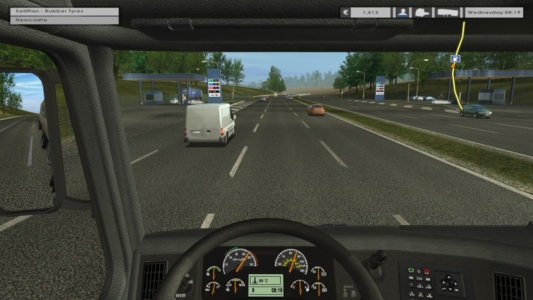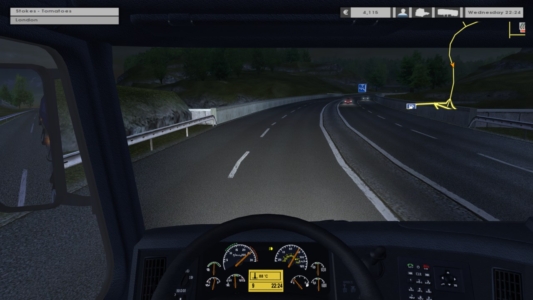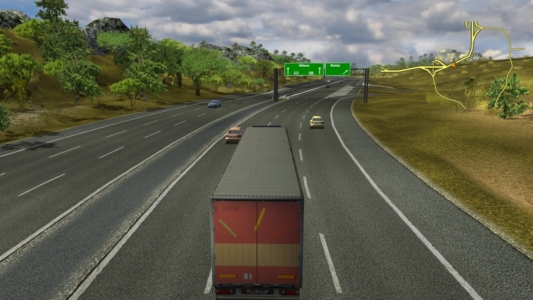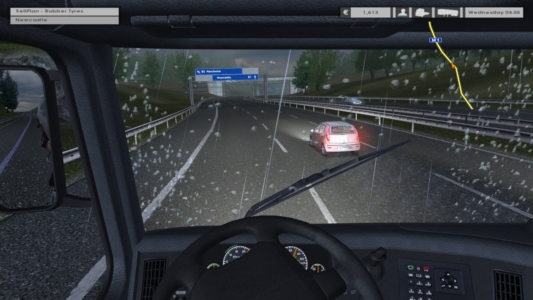
Euro Truck Simulator
Written by: The J Man
Date posted: October 2, 2013
- Genre: Simulation
- Developed by: SCS Software
- Published by: SCS Software
- Year released: 2008
- Our score: 4
As Rik pointed out in his review of Test Drive III, there’s something novel about poking around a functioning simulation of a car. Flicking on working headlights and windshield wipers gives you that extra sense of realism that elevates a good car sim above the pure arcade racers of Daytona or Crusin’. That’s why I understand the initial appeal of a game that tries to simulate the mundane lifestyle of a long-haul trucker, even if my first reaction was “this sounds like work instead of fun.” And also, admittedly, because Steam sales make you buy crazy things.
Euro Truck Simulator starts you off with an underwhelming truck and one country of your choosing from a map running from Portugal to Poland (minus Luxembourg and anything smaller). You’ll use this truck to take contracts from a series of fictitious goods providers, link up with the trailer full of cargo, and drive it to wherever it needs to go. That’s the entire game. Any money you make goes toward truck upgrades, a powerful new chassis, or unlocking the ability to take contracts in countries adjacent to any you’ve unlocked previously. There’s no benefit to starting in one country over another, as smaller countries include larger neighbors as well (choosing Belgium also unlocks France, for example).
The value of each route is almost entirely dependent on distance traveled, which is why opening up new countries is a top priority. You can also purchase licenses to handle more valuable cargo – explosives, chemicals, and fragile shipments – though these don’t raise the payout as much as a long drive will. Along the way you’ll need to pay for fuel as needed, sleep at rest areas if fatigue is setting in, and pay for truck and tire maintenance in between runs. Run out of gas or let your truck break down, and you’ll need to call (and pay for) roadside assistance. Chow and potty breaks for your virtual trucker are sadly not simulated.
You can choose manual or automatic transmission at the options screen instead of per truck. Manual transmission does not include a clutch (just “shift up” and “shift down”) and works only in increments. Trucks apparently need to reach about 5th gear before they move at more than a crawl, so be prepared to hammer “shift up” after every stoplight. Headlights, horns, wipers, and cruise control all function. You can click on left and right turn signals, which hopefully will keep other drivers from trying to pass you on a lane change. You can even engage a parking brake, which does nothing practical except make you feel confused, then stupid for leaving it on.
Interestingly, there’s no GPS or arrow indicators here. You will never be given a clearly-marked route to mindlessly follow. Instead, you’ll need to rely on the maps, in either a detailed version in your notebook (the N key) or a miniature overlay (the M key). You can toggle the overlay off for authenticity. Signage on all highways is also accurate and easy enough to follow. You could conceivably miss a turn or an off ramp somewhere, but actually getting lost seems impossible. You’ll also need to obey traffic laws, and are fined automatically for speeding, any collisions, or red lights run. The side of the road you’re driving on also varies appropriately by country.
It may sound somewhat daunting (especially the “no GPS” part), but plenty of simplification makes it anything but. For starters, countries have a maximum of four cities, with smaller countries having only one. You’re further limited to tiny industrial areas on the outskirts, no more than two or three blocks, with routes into the city proper blocked off by floating yellow barriers. You can never leave the highways that connect these cities, and trying will introduce you to an invisible wall. Towns in between the major cities simply don’t exist, on either the map or the game world.
This means, as you would expect, there’s not much to see here. Some effort has been made to consider local flavor, so there’s rolling English countryside versus tall pines in Poland, and of course you’ll be able to see the Eiffel Tower from within Paris. But the vast majority of the game is bland motorways no matter where you are. Distances are thankfully compressed into something that allows you to drive from London to Newcastle in 10 minutes, so at least you’re not asked to do this in real-time. Game time is compressed accordingly, so day/night cycles faster, but there’s no practical effect in-game. You’re never given a deadline for your delivery, and you’ll receive full payment as long as the cargo arrives undamaged.
As a result of the above, the actual gameplay is quite easy. Memory restrictions mean there’s never more than 10 cars on screen at once. You can swerve around a bit without running into anyone, aided by driver AI that will actively try to avoid collisions. There are no penalties for reckless driving. You can stop in the middle of a highway, or reverse to a missed turn if you want. You can never flip your truck over, and an unhitched trailer can be easily recovered. There are no random events to watch out for, such as blown tires or traffic jams, and your truck will only break down due to intentional lack of maintenance or repeated crashes. The fatigue system can be toggled off entirely, but even with it on, you’ll never fall asleep at the wheel and be forced off the road.

Filling stations offer your only places to refuel or rest. It’s possible to miss the last station for a while, and that’s bad.
So, with very little effort, every run is counted as a perfect run (even if your driving was shamefully sloppy). There are only a handful of automatic penalties, and too few cars to make careless driving dangerous. Adding to the boredom, low payouts ask you to run plenty of routine trips before you can afford anything. Expansion into new countries costs between 35 and 60 thousand euros. New trucks cost between 100 and 160 thousand. You will average four thousand for a trip from one side of a country to another, and even cross-continent trips (only available after paying generously to unlock new countries, mind) will only net you in the range of 25 thousand. To put it simply, you’re going to be playing for a while.
Worse, there’s very little to spend your money on anyway. Euro Truck 2 introduces your own shipping company to run and AI truckers to hire and manage, but in the first game, it’s just you and your personal contracts. Once you’ve bought and tricked out your favorite truck and unlocked all the countries, then you’re just going for a high score. A limited achievement system offers some goals to rank up to “master,” but these are basic challenges you’ll be completing in the course of your game already. I find it amusing that King of The Road from six years earlier actually does the “variety” and “open world” aspects better than is done here.
Loose controls mark the final disappointment. It’s a good thing you’re not ticketed for erratic driving, because you’re almost guaranteed to swerve all over the place. Proper wheel and gamepad support is not included, so you’re limited to joystick sensitivity settings. Using a gamepad, it took me a long time to find a combination of settings that didn’t jerk the wheel around on a whim, but even then, driving was never smooth. Keyboard controls are worse. The wheel turns based on how long you hold down the key, requiring a litany of spastic taps to maintain even the slightest turn. There’s also no “weight” to the truck, and no consequences to taking turns too sharply or slamming on the brakes.

Notice it’s nearly midnight. The default night is way too bright, luckily there’s a mod to fix this.
Visually, the game does all right. Sunsets are pretty, cars look the part, and the rolling countryside suffers more from lack of variety and detail than visual quality. The inside of your cab is fully modeled, with different layouts for the game’s four manufacturers. Gauges all function, but unfortunately, you cannot click around on any controls. Audio offers only what you’d expect, with quality engine noises and the sounds of the road whooshing by your window. You’re required to bring the music though, and the in-game radio will only accept that large collection of .ogg tracks you don’t have.
In closing, Euro Truck Simulator feels like a prototype of a “crazy, but it might work” concept. The physics need to be improved, the controls tweaked, the world expanded, and the range of interesting things to spend your money on increased. Euro Truck Simulator 2 does all of this, and is a vastly better game for it (it also seems to have taken the lion’s share of mods). Retrospectively, the first game functions well enough, and does what it says on the tin, but if this just sounds to you like a modern version of Penn and Teller’s Desert Bus, the lack of depth means you’re not far off. If you’re interested in the concept, get the sequel.




 Posts
Posts
King of the Road benefited from my (at the time) ignorance of other, similar, games (such as the 18 Wheels of Steel series) and so I gave it points for originality that it probably didn’t deserve.
I liked the concept, but the game was boring. But then, as I mentioned recently – driving is boring. So it sort of makes sense that a game where you drive on bland motorways for miles and miles would be too.
They’ve obviously cracked it with the sequel to this, though – I’ve heard good things.
October 4, 2013 @ 1:42 pm
There’s a Euro Truck 2 demo on Steam which is where I got most of my information. Worth a look. Of course, when both were on sale, I went with the cheaper one… But luckily, I guess, I won’t be spending my free time hauling wares.
October 4, 2013 @ 6:11 pm
Had a go at the Euro Truck 2 demo. On the one hand it feels like work, but on the other – strangely compelling. Well, as compelling as hauling 17t of fertiliser to Rotterdam has any right to be.
October 6, 2013 @ 9:02 pm
I am not ashamed to say I own both this and the sequel and have spent a borderline foolish amount of time playing them. There’s something about it that gets strangely addictive…
October 8, 2013 @ 5:45 am
My ‘quick go’ of the demo of Euro Truck 2 soon turned into a couple of hours. I haven’t played the original but you definitely get the “weight” of driving a big rig in the sequel – nervously eyeing your mirrors to see if your trailer is going to clip a sign or get stuck on the kerb.
I also now have some sympathy for truck drivers who try and overtake another truck and then can’t quite manage it…
October 8, 2013 @ 10:47 pm
Backing up and trying to pick up/put down a trailer was the biggest pain in the ass in the early going of ETS 2 for me…and that’s with the luxury of the top-down camera…how actual truck drivers (like my father, actually) do this with only the mirrors and looking around is beyond my skill level…and yes, he thought it was kinda cool that someone actually made an honest simulation of his profession.
October 11, 2013 @ 4:41 am
Oh God, the parking. Have tried and failed to get anywhere close to the marked bay thus far. Mind you, in real life the thought of parking anything larger than a mid-range hatchback terrifies me.
October 12, 2013 @ 12:36 pm
ETS 1 requires you to back up to the loading dock, but it seems much easier than in ETS 2 – maybe because of the better physics in the sequel. Either way, I’m glad ETS 2 gives you the option to just dump the trailer at the front door for less “trucker XP.”
October 12, 2013 @ 6:16 pm
Yeah, the physics are a lot looser in ETS 1…you can also put your truck on its sides fairly easily in the sequel, although I find it weird ETS 2 capped your speed at 90 kph unless you were going downhill…
October 15, 2013 @ 8:49 am
Pretty sure the speed cap in ETS reflects EU law that all trucks have to feature a limiter.
October 15, 2013 @ 5:49 pm
Ah…in that case, that’s actually a pretty good bit of sticking to realism.
October 19, 2013 @ 8:48 am
I passed on a double pack of this and something called UK Truck Simulator at the weekend for not very much. Apparently it’s developed by the same people, but not sure of the other differences between it and ETS, except you can probably visit even less desirable destinations than Newcastle and Manchester.
Think I’ll pick up the sequel instead.
October 21, 2013 @ 4:45 pm